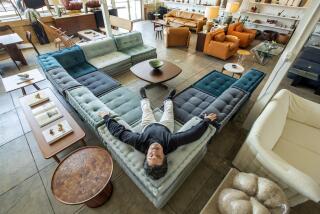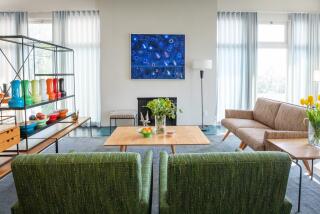FURNISHINGS : Milan Puts Modesty on the Open Market
- Share via
MILAN, Italy — A populist revolution occurred earlier this month at the citadel of contemporary design.
The Milan Furniture Fair, now in its 34th run, annually draws tens of thousands of furniture fans from across the globe. They flock here to spot the freshest trends in this unofficial capital of furniture design. But this year, instead of the opulent or outlandish creations that once characterized the cutting edge, they found workmanlike furniture slimmed down to the bare essentials. Even the price tags, once gold-plated, had minimalist undertones.
The new fashion from Milan is furniture you can use at prices you can afford.
“Molto bello!”-- How beautiful--exclaimed an elegant Milanese dressed in Krizia and sensible shoes. She was delighted by a simple, fold-down desk from Ikea, about $250, just one example of the new, functional wave in furniture.
Yes, even Ikea had joined the front lines. This was the first time in Milan for the Prince of Low Prices. The Sweden-based company has been selling furniture to the masses since 1950.
Though its presence seemed more a symbol of the times than a threat to the established players in designer furniture, it had set up shop at a palazzo in the heart of Milan, virtual Ground Zero for Italian design. A banner over the street entrance advertised “Design Democratico!”
Inside the gates, 20 young Swedish modernists exhibited the company’s first “designer” collection, called IKEA PS; it included everything from chests on wheels to tableware. The look was spare, but the price tag dangling from an easy chair was a comfy $168.
Italian companies were not to be outdone. Just down the fashionable via Manzoni, sleek and pricey Driade was introducing its own bare-bones collection. Called Atlantide, after the Lost Continent, its chairs, tables and bookcases were priced in the hundreds of dollars, instead of the usual thousands.
The new team of designers brought in to create the line were not even calling this furniture; it was foldable, rollable “equipment for the Third Millenium.”
The high-end company was determined to go “down market” this year. Said Marco Romanelli, an architect and the consultant behind Atlantide, “You can’t do minimalist designs without minimalist price.”
Could this be the same lively, bellwether furniture fair that for years has given the world cutting-edge design at extravagant prices? Were they putting something in the pasta?
“The casa is crumbling,” said George Beylerian, a senior adviser to the Steelcase Design Partnership and a regular fair-goer from New York.
He added later, “They talk about beauty here; the reality today is price.”
Affordable. Functional. Minimalist. It’s a new, sober vocabulary for the fair, formally known as the Salone Internazionale del Mobile. After several years of soft sales, organizers had put out the word that 1995 would be a year of recovery.
They rolled up their sleeves to greet more than 1,300 exhibitors and 150,000 buyers and other visitors from 120 countries. Accessories and kitchen shows were held simultaneously at the sprawling trade fairground.
“This is one of the most subdued fairs I’ve seen in a while,” said Sergio Palazzetti, president of the New York-based Palazzetti stores. “Everything is geared to things that will sell. They were not setting new trends.”
Clearly, the drift toward modesty is rooted in business woes. Stung by Europe’s recession and made cautious by Italy’s changing political landscape, some of the biggest manufacturers have lowered prices. Smaller ones were reluctant to invest in risky styles that might not sell.
The idea of budget chic surfaced last year with “Lord Yo,” Driade’s $160 plastic chair by Philippe Starck, a leader in avant-garde furniture design. By this year, the concept had flowered as other high-end designers and firms turned to the needs of ordinary mortals: limited budgets, furniture that serves a purpose, design that doesn’t overwhelm.






